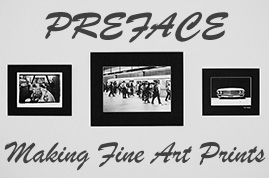Making Fine Art Prints: Preface
Before we dive into the main topics for this series, I wanted to mention a few things to set the tone. These are things that should hold true for the length of the series, and I don't want to waste precious real estate on repeating myself with each article (plus, it's really boring to hear over and over).
If you're planning on following and participating in the “Making Fine Art Prints” series, be sure to read through this stuff at least once. I'm just trying to lay the groundwork for what's to come so there's less confusion and more interaction.
THINGS TO KEEP IN MIND
First and foremost: this is a discussion, not a lecture. I'm planning on learning a few things from the rest of you, so participation both ways will be key. With that said, keep in mind that we all have different opinions and different ways of doing things. This group has always been awesome at keeping things civil and educational, so I'm sure we won't have any issues.
THE COMMON THEME
Throughout the series, there will be one common message: Do what you want. We won't be getting into the legal complexities of “limited edition” fine art prints, and there's really not a standard set of methods out there for producing fine art outside of that scope. The downside to this — there also aren't a lot of guidelines or suggestions documented. The upside — you can pretty much do what you want and it won't be wrong.
The final test for a fine art print is that it passes your criteria for approval. This means that you have to think about your standards of quality and how you want to present yourself as an artist. It doesn't take long to gain a bad reputation if others perceive your presentation of work as “low quality” — so do what you want when making fine art prints, but remember that your reputation is on the line.
WHAT WE WILL COVER
We will talk about each of the topics to whatever depth the community wants. The articles I write will start the discussion with basic overviews and generalities, and the comments can be a forum for specific discussion and sharing of knowledge. The more discussion, the deeper we go — so be sure to participate. Ask questions if you don't know something, and answer questions if you do.
WHAT WE WON'T COVER
Before we jump into the content, I want to make sure that I'm not giving a heightened expectation of what will be discussed in the articles. For example: I listed one of the main topics as “Printing”. Yes, we'll be talking about printing. But I won't be talking about specific hardware, software settings, darkroom methods, etc. Same type of thing with signing. I'm not going to tell you how to hold the pen 😉 . Again, if the community wants to dive into those things within the comments — let's go for it.
AND REMEMBER…
Let's have fun with this! I've written a few series in the past (Adobe Bridge and Photo Backups), but this one is shaping up to be a bit different. I'm hoping that we have even more discussion among the community, and I'm even planning on incorporating some of that discussion back into the articles (and possibly another eBook at the end).
We'll officially kick-off the series on May 26 because of the holiday on Monday. I'm hoping to get through one or two of the topics each week, depending on the level of discussion immediately after I post the article. So stay tuned!
FOLLOW THIS SERIES OF ARTICLES!
BACK — INTRODUCTIONS
NEXT — PREPARING

Studio M.M.E.
May 25, 2009Thanks for the information! I can’t wait to read more.